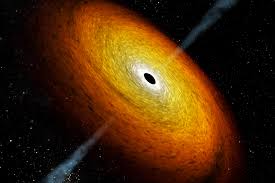Black Holes have been beguiling from the very beginning. Hinted at as early as the1780 and predicted by Einstein's General Relativity Theory, they didn't get the name we know today until the 1960's. bizarre beasts that squash gobs of matter into infinitely dense abyss, Black holes were once thought to be mere a Mathematical curiosity.
In this chapter we need to distinguish between normal Black holes and super massive black holes. Normal black holes are believed to be the result of stellar evolution. End product of a star is white dwarfs, neutron star and black holes. Stars that have the masses greater than around five times the mass of the sun may end up as black hole.
Super massive black holes are those that are thought to be a million of solar masses or greater, and they have only been found in the middle of the galaxy.
In terms of observation, not many scientists believe that black holes could actually exist in nature. However, in 1963, Marten Schmidt discovered Quasars. And the search of black holes was born. Quasars are extremely bright, small object. They are considered bright since they are extremely distance from us, yet we can easily see them. The average Quasar is seen at a distance when universe was 1/4th of its present age.
One of the strongest arguments for the Quasars is that it is a black hole that is actively feeding. Quasars are more abundant in the past------We see very few Quasars locally. The idea is that as the galaxy forms, there is more materials around for a black hole to eat . After it is gone , then it becomes quiet. Thus there should be lots of dead Quasar around and the number suggests that most galaxies may have gone through a quasar phase. Therefore, every galaxy might have a black hole.

In the 1980s, astronomers began searching for super massive black holes in earnest. The first suggestion was in the galaxy M87---the giant central galaxy in the Virgo clusters of galaxies. Remarkably, the black hole mass estimate is very close to present day measurement.
However, the big boost for black hole searchers came when the Hubble Space Telescope was launched. The search for stellar black hole started around the same time as that for Super massive one. The best candidate was CYG X-1, a binary system.
Today there are about 20 stellar mass black hole candidates that ranges in masses form 3-15 solar masses.
Please follow the below link for previous chapter :-
Chapter 1 - https://cnewsliveenglish.com/news/23704/revealing-the-secrets-of-black-holes-tm
Watch this space for more insights!